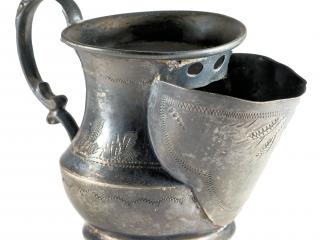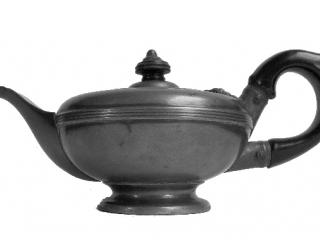Britannia metal
A trade description for a pewter alloy containing a comparatively high proportion of antimony – typically 92% tin, 6% antimony and 2% copper.
This alloy was first introduced by Sheffield manufacturers in the second half of the 18th century and is a product of the industrial revolution. It was also known in its early days as white metal
As an alloy it has characteristics which permit articles to be made by cold-forming the alloy in sheet form (e.g. by spinning or stamping) rather than by casting. N.B. Some earlier books assert, possibly due to ignorance of the contents of the alloy, that Britannia Metal is not pewter!
In 1769 James Vickers discovered that with the addition of more antimony to the pewter mixture, the resultant alloy could be turned into a sheet of metal. So instead of using expensive moulds to make castings, the resulting mixture in cooled sheet form could be cut, shaped, (by hand or spun on a wooden former) and the resultant pieces soldered together and an inexpensive version of the traditional pewter product was made.
Sheffield had been doing sheet metal for a while (silvered copper instead of solid silver for example) and the expertise was there. The industrial revolution was starting. Power driven machinery in factories instead of small units at home or in the back of the shop became the order of the day.
By the early to mid 1800s these factories grew bigger and turned out thousands of pieces at far less cost and lower selling prices than the traditional methods could compete with. This was not unusual, it happened with lots of previously cottage type industries – textiles for example.
Thus the wonderful design work and skill of those who had to work in the factories continued as people with talents could still rise above the rank and file of the other workers and express their design skills.
These skills and talents, though because it was factory production, have scarcely ever received any acclaim and the value today of those products is usually negligible and derisory. Perhaps this is something to collect that can be found in good condition is very inexpensive and was perhaps made over 140 years ago.
So what was made? All that was previously made in cast pewter was going to be found in Britannia Metal albeit made in the fashions that the age would buy. The new social habits of tea and coffee drinking and different eating rituals were catered for. The different concepts of designs for the age defined the factory production and the designer’s tasks.
This is a very simplistic summary and approach to explaining Britannia Metal Pewter.
For perhaps the best book ever written on the subject you might consult –

